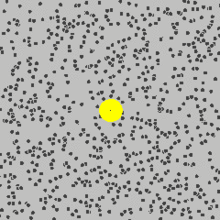Main Page: Difference between revisions
Jump to navigation
Jump to search
No edit summary |
Bradley Monk (talk | contribs) No edit summary |
||
| (113 intermediate revisions by 2 users not shown) | |||
| Line 1: | Line 1: | ||
{{SmallBox|float=left|clear=both|margin=0px 1px 8px 1px|padding=10px 1px 10px 1px|width=95%|font-size=16px|Genomics and Machine Learning|txt-size=12px|pad=6px 12px 2px 12px| | |||
---- | |||
{{Box|width= | |||
[[ | Using SNP profiles we have developed a computational framework for making diagnostic predictions regarding the likelihood that someone will develop dementia. A key feature of this framework is a neural network algorithm that, through machine learning, has been trained to predict patients or controls with high accuracy. Importantly, these predictions have proven to generalize well to hold-out genomes from independent sequencing projects, suggesting the classifier may perform well across samples of the general population. The bp status of just ~1k genomic loci was sufficient to to have 80% prediction accuracy. Furthermore, the neural net outputs a ‘confidence’ score for each prediction; on high-confidence predictions the classifier is over 90% accurate (''confidence'' is not quantified ''post hoc'', it is divined ''a priori'' by deep neural nets). Since the neural network weights have been trained, and because only a relatively small number of genomic targets are needed, we hope this system can be further developed into a clinical diagnostic tool. As it is, this is still far off; many independent test genomes will be required to validate such a tool. In the meanwhile, we hope to continue to improve the classifier's performance using novel data and methods. | ||
}} | |||
{{Box|width=45%|min-width=300px|float=left|font-size=14px|[[Actin|Actin Modeling]]| | |||
The study of actin dynamics is centrally important to understanding synaptic plasticity. Fortunately, actin research has provided a vast pool of experimental studies, and several quantitative models that provide excellent characterizations of actin polymerization kinetics. To simulate filament scaffolding in a dendritic model, I developed a stochastic 3D model of actin dynamics based on parameters from previously established in steady-state, monte carlo and stochastic models. The ability to simulate the evolution of actin networks in 3D makes this model unique. | |||
<br><br> | |||
[[File:Actin modeling.png|right|600px]] | |||
}} | |||
{{Box|width=45%|min-width=310px|float=right|font-size=14px|[[:Category:Synaptic Plasticity|Synaptic Plasticity]]|[[File:Synapses web.jpg|center|500px|link=Synaptic Plasticity]]{{Clear}} | |||
It is now generally accepted that many forms of adaptive behavior, including learning and memory, engender lasting physiological changes in the brain; reciprocally, neural plasticity among the brain’s synaptic connections provides the capacity for learning and memory. Whenever I have to summarize my primary research focus using just a few words, they always include: "'''''synaptic plasticity'''''". Indeed, I feel that the key to fully understanding cognitive processes like memory formation is through studying neural dynamics at the cellular-network, synaptic, and molecular levels. | |||
}} | |||
<!-- ####################################################### --> | |||
{{Clear}} | |||
<!-- ####################################################### --> | |||
{{Box|width=45%|min-width=310px|float=left|font-size=14px|[[Neural Nets|Machine Learning Tutorial]]| | |||
[[File:Neural-net-01.png|500px|link=Neural Nets]]{{Clear}} <br><br> | |||
I have developed a [[Neural Nets|machine learning tutorial]], focusing on supervised learning, but it also touches on techniques like t-SNE. It makes heavy use of Tensorflow Playground to visualize what is happening in multilayer neural networks during training. It also provides learners with an opportunity to try and solve problems classification problems live right on the web app. | |||
<br><br> | |||
}} | |||
{{Box|width=45%|min-width=310px|float=right|font-size=14px|[[Brownian Motion]]| | |||
Molecular-level synaptic plasticity is among my primary interests. I've studied and quantified membrane [[:Category:Diffusion|diffusion]] properties of excitatory and inhibitory receptors, and have developed models how these particles swarm to potentiate synapses. I find stochastic particle diffusion is intertwined with the first principles of [[:Category:Statistics|statistics and probability]]. Given that synaptic potentiation is dependent on marshalling receptors undergoing stochastic diffusion, it seem that neurons have evolved into innate statistical computers. The result of 100 billion of these statistical computers making 100 trillion connections is the human brain. Here are some of my [[:Category:Diffusion|notes and code for simulating membrane diffusion.]] | |||
---- | |||
[[File:Brownian-Diffusion.gif|350px|center]] | |||
}} | }} | ||
{{Box|width=45%|min-width=340px|float=left|[[Hello]] internet person!| | |||
You've found [[User:Monakhos|my wiki]]. This is where I horde random information. I have every intention of linking it all together someday. If you are so inclined, recent additions to this wiki can be found in the box on the right. For a non-curated glimpse of my activity you can check out the [[Special:RecentChanges|latest wiki updates]]. Older wiki [[content]] can be accessed using the <nowiki>[search box]</nowiki> or perusing [[Special:AllPages| all pages]]. If you would like to contact me, you can find this info on [http://bradleymonk.com my home page]. You can find a list of my [[publications]] here. | |||
}} | |||
{{Box|width=45%|min-width=310px|float=right|Popular Pages and Categories| | |||
{{SmallBox|float=left|clear=none|margin=1px 1px 1px 10px|padding=1px|width=45%|font-size=12px|border-style=none|text-align=left| | |||
*[[:Category:Synaptic Plasticity{{!}}Category:Plasticity]] | |||
*[[APOE]] | |||
*[[:Category:Journals]] | |||
*[[:Category:Math]] | |||
*[[:Category:Neuroscience Methods]] | |||
}} | |||
{{SmallBox|float=left|clear=none|margin=1px 1px 1px 10px|padding=1px|width=45%|font-size=12px|border-style=none|text-align=left| | |||
*[[Genomics Terminology]] | |||
*[[:Category:Diffusion]] | |||
*[[:Category:Qual]] | |||
*[[:Category:Neurobiology]] | |||
*[[:Category:Malinow]] | |||
}} | |||
}} | }} | ||
<!-- ####################################################### --> | |||
{{Clear}} | |||
<!-- ####################################################### --> | |||
__NOTOC__ | |||
[[ | [[Category:Neurobiology]] | ||



